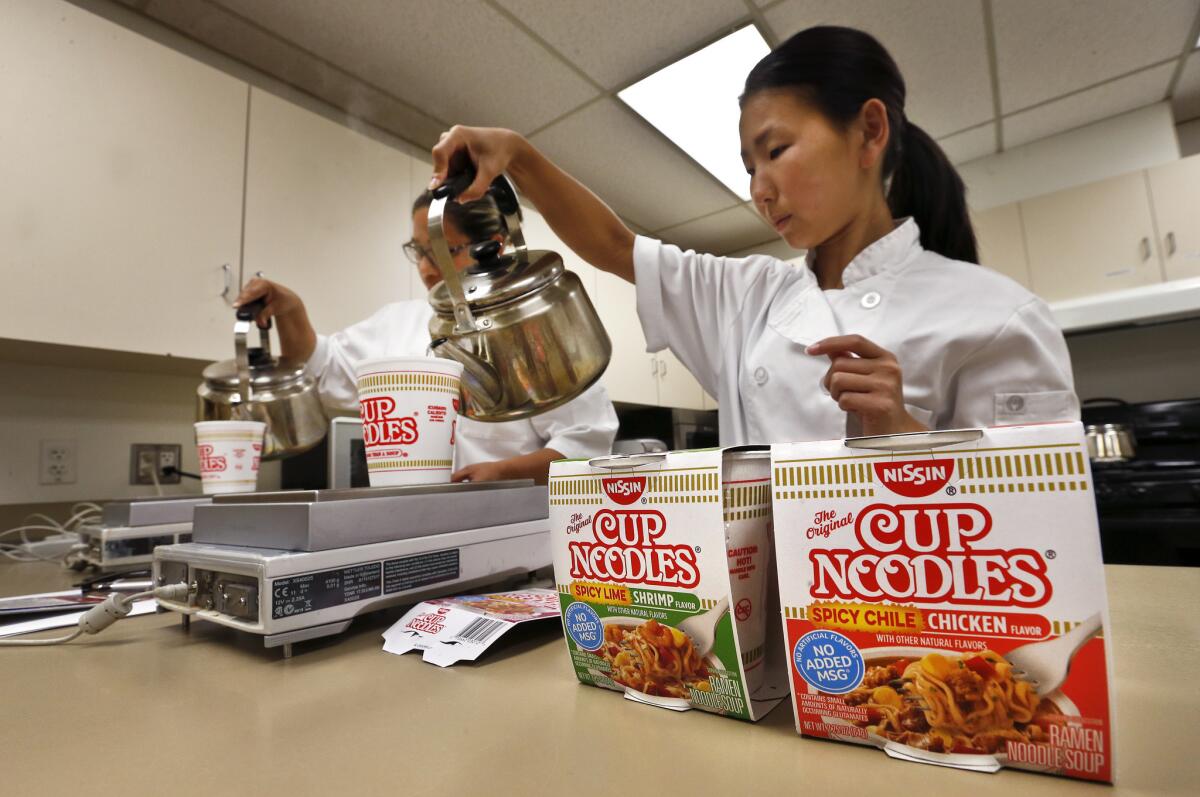Cup Noodles changes its recipe for the first time ever, hopping on the healthier food trend

Cup Noodles is getting a new recipe — with less sodium and MSG — for the first time in its 45-year history.
Cup Noodles became a staple in college dorms because of its cost and convenience. If you had pocket change, boiling water and three minutes to spare, you could eat Japanese ramen — or at least an approximation of it — out of a handy foam cup.
But in the 45 years since Cup Noodles first appeared on supermarket shelves, Americans have become increasingly inclined to read nutritional labels even in the snack aisle. Now food companies are scrambling to catch up to changing tastes, introducing organic Gatorade and unsalted Kettle potato chips to appeal to health-conscious diners.
On Thursday, Nissin Foods USA — the Gardena-based arm of the Japanese instant noodle giant Nissin Foods Group — said it, too, is changing with the times. For the first time, Cup Noodles is getting a recipe overhaul. All eight flavors — which contain fried noodles, seasoning and dried ingredients such as vegetables — have been retooled by reducing sodium and stripping out MSG and artificial flavors. The new versions will be available only in the U.S.
A first-ever national advertising campaign will launch in coming months to introduce the changes to Cup Noodles, which helped the company rack up $3.6 billion in global sales in its 2015 fiscal year.
Before the change, Cup Noodles’ most popular flavor, chicken, contained 1,430 mg. of sodium — about 60% of the daily recommended intake. The new version, which has started hitting store shelves, contains 1,070 mg. of sodium — about 45% of the daily recommended intake. Hydrolized vegetable protein has replaced artificial MSG. Green cabbage juice was added to boost the taste.
Al Multari, chief executive of Nissin Foods USA, said the recipe changes were in direct response to feedback from customers, who wanted the same taste but with an improved nutritional profile.
“They were saying, ‘We love your product, but we’d really like to see these changes made,’” Multari said.
The Cup Noodles tweaks come as long-standing food brands are racing to keep up with a rapidly evolving American palate that’s starting to favor grab-and-go salads over burgers and fries.
Fast food chains such as McDonald’s, which have been struggling, are touting changes intended to appeal to a new generation of diners, such as cage-free Egg McMuffins. Taco Bell, Pizza Hut and candy-maker Nestle USA have said they are axing artificial ingredients. Kraft has rolled out a less lurid version of its classic macaroni and cheese without synthetic colors.
Other noodle makers have already made similar tweaks. Toyo Suisan Kaisha, which makes a popular brand called Maruchan and racked up $3.2 billion of global sales in the 2015 fiscal year, has rolled out products that contain 35% less sodium. Its Instant Lunch chicken flavor, which comes in a cup, clocks in at 660 mg., or about 28% of daily intake. Nongshim’s Shin brand also offers noodles without added MSG.
Multari, who last year became the first non-Japanese or Japanese-American head of the company’s U.S. arm, said Nissin hoped such changes will help boost Cup Noodles sales, which have been flat in recent years (there was a slight uptick during the Great Recession, and then sales fell and eventually plateaued as the economy improved, he said).
That same sluggish performance can be seen in the overall industry. U.S. sales of instant noodles was $1.06 billion last year, up just 4.1% from $1.02 billion in 2010, according to research firm Euromonitor.
Americans rank fifth worldwide in demand, out-slurped only by China, Indonesia, Japan and Vietnam, according to the World Instant Noodles Assn. However, U.S. consumption has fallen slightly. Last year, Americans chowed down on 4.2 billion servings of instant noodles, down from 4.4 billion in 2013, the association said.
The slowdown for instant noodles comes as ramen is enjoying a moment in the U.S. After chef and restaurateur David Chang opened Momofuku Noodle Bar in New York, more ramen restaurants have popped up around the country. In Los Angeles, well-known ramen shop Tsujita is opening an outpost in the Americana at Brand; in downtown L.A., several are opening up including Tokyo Strike and Ramen Hood.
“This is a growing category,” said Jim Prevor, a food analyst at the Perishable Pundit. “Everyone is looking at it and trying to hook onto it.”
That’s in part due to Asian transplants, who are the fastest-growing immigrant group in the U.S., Prevor said. Many dishes once foreign to Americans, such as sushi and pizza, have now become commonplace foods.
At Nissin, executives say they hope the new recipes will expand the demographic of Cup Noodles buyers, who fall heavily into two camps: millennials, such as college students, and lower-income folks who rely on Cup Noodle’s affordability. The price — 45 cents or less per cup — is also staying the same despite the added cost of the new ingredients, they said.
“We have a lot of light and medium users that are kind of managing how much they eat because they know it is high in sodium,” said Leslie Mohr, vice president of marketing. By addressing those concerns, she said, the company believes those customers will be encouraged to buy Cup Noodles more frequently, and even lure “lapsed users” to try it again.
Cup Noodles is Nissin’s second bestselling brand in the U.S. Top Ramen, the No. 1 brand, isn’t packaged as a single serving and doesn’t come with its own cup.

In 1958, Nissin founder Momofuku Ando introduced Japan to instant ramen, a concoction he invented in a backyard shed. But the idea of selling noodles in their own cup — Nissin’s claim to fame — was inspired by Ando’s 1966 trip to America. There he witnessed office workers divvy up a package of ramen, place the pieces into paper cups and add hot water, according to company lore.
The new recipes were developed in the sprawling facility, which opened in 1970, about 13 miles southwest of Los Angeles. It spans 17 acres with office space, a warehouse and a factory that churns out “hundreds of millions” of Cup Noodles a year, Multari said. A second manufacturing plant is located in Lancaster, Pennsylvania. The company employs about 400 workers nationwide.
Inside the test kitchen, about 10 employees equipped with four microwaves and three fridges have been working for a year to recraft the Cup Noodles recipe.
Monique Au-Yeung, a senior research and development specialist, acknowledged the process was sometimes frustrating. It took 13 tries, for instance, just to revamp the chicken variety alone. “It’s a balance of all materials for the flavor,” she said. The trickiness often came “towards the end, where you have to fine-tune the flavors.”
Rachel Scherr, an assistant research scientist at UC Davis’ department of nutrition, said any nutritional improvement was a step in the right direction. But Cup Noodles still contains a high level of sodium, she said, and the sodium replacement, potassium chloride, is not necessarily healthier than salt, she said.
“I would say it’s a sometime food, not an everyday food,” she said.
Some analysts questioned whether Nissin could really makeover Cup Noodles’ reputation.
“It’s very hard to change people’s perceptions of brands,” food analyst Prevor said. “It usually fails, and it fails because to the extent you attract new people, you get push back too from people” used to the old version.
Prevor said that recipe changes are touted by companies as revolutionary, but often “smells of marketing more than it does of a brilliant new product.”
“I’m surprised they changed the formulation of their current product as opposed to coming out with another line that is higher-priced and healthier,” he said.
Considering the new ingredients cost more (a “significant” increase according to Multari), Nissin may very well raise prices after the new Cup Noodles is firmly launched into the market, Prevor said.
Multari said the Cup Noodles overhaul is just the first step. He said the company will quiz customers on other Nissin products, which could be tweaked as well.
“It’s a challenge for all brands to always remain relevant,” he said. “That’s what we’re trying to do.”
Follow Shan on Twitter @ByShanLi
ALSO
FDA super-sizes key information in nutrition labels for packaged foods
New Dietary Guidelines spark intense debate among nutrition experts
Sugar industry funded research to cast doubt on sugar’s health hazards, report says







